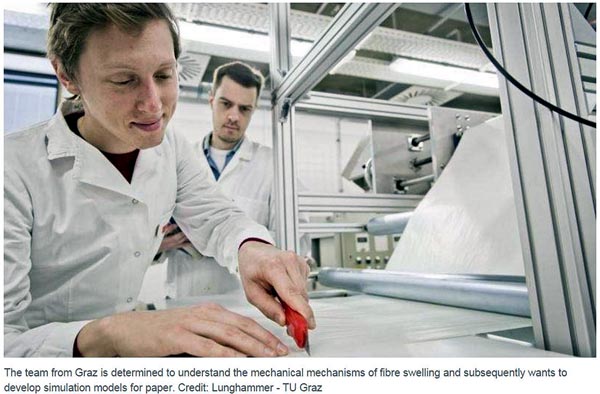Establishing Models of Fiber Swelling When Paper is Wetted or Dried
According to a report this past week by PhysOrg, U.K., paper is a sophisticated, multi-faceted natural material. It has to satisfy many partly conflicting demands all at the same time, covering the full range from industrial printing to its use as a packaging material. The "Christian-Doppler (CD) Laboratory for Fibre Swelling and its Influence on the Properties of Paper" recently opened at Graz University of Technology in Austria (TU Graz).
Paper is everywhere and has to satisfy all manner of requirements. For a start, it has to be permeable to air, stable, and tear-resistant. It must also optimally absorb pigments and avoid undesirable changes of shape if it is wetted. Depending on the application, these properties must be combined perfectly. The new "CD Laboratory for Fibre Swelling and its Influence on the Properties of Paper" at TU Graz will investigate how to optimally combine the key characteristics of paper to achieve the desired result.
"Wood and paper are industries with a long tradition in Austria," explained Dr. Reinhold Mitterlehner, Austria's federal minister of science, research, and economy. "The laboratory will contribute to technological progress in these important segments. This will benefit all participating partners and, in the long term, Austria as a location of industry."
Paper is produced from renewable natural resources and – contrary to many other packaging materials – it is biologically degradable. As an everyday product, it seems to hold few secrets. In spite of this, many questions remain unanswered. For instance, it is still unclear how individual paper fibers behave if printer's ink is applied, or how moist paper can be prevented from bulging or curling up. The team of Ulrich Hirn from the Institute for Paper, Pulp, and Fibre Technology at TU Graz is searching for scientifically sound explanations in the recently opened CD laboratory.
As Ulrich Hirn, head of the Laboratory, points out, "The swelling processes within the paper fibers are particularly relevant in modern high-speed inkjet printers. The less swelling occurs, the quicker the paper will dry. On the other hand, swollen fibers increase the strength of paper. If we are to optimally mix paper properties for each field of application, we need to understand, describe, and ideally simulate the absorption of water as well as the mechanical processes down to the individual paper fiber. In the next seven years, this is our mission in the CD laboratory."
More specifically, the team of the CD laboratory plans to establish precise mechanical models of the swelling processes that occur when paper is wetted or dried, and it will develop modification and improvement concepts as the basis for paper simulation for the development of printing machines. The scientists rely on the support of two big corporate partners: Mondi Uncoated Fine and Kraft Papers, a paper company headquartered in Vienna, and Océ Technologies B.V., a manufacturer of industrial printing machines and a member of the Canon group of companies with principal place of business in the Netherlands.
TAPPI
http://www.tappi.org/

